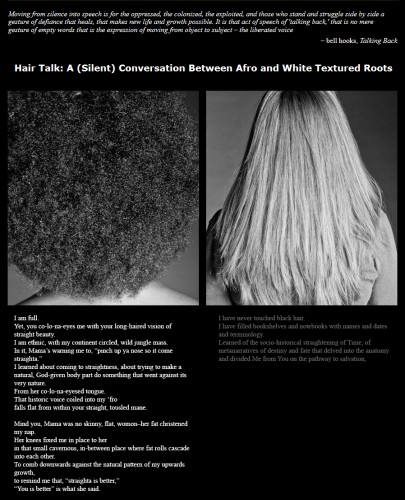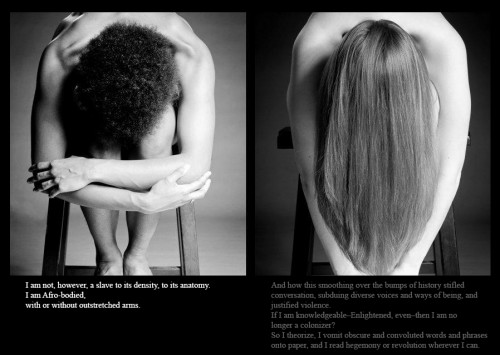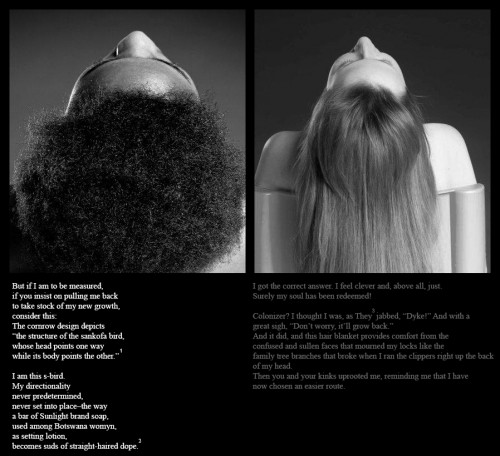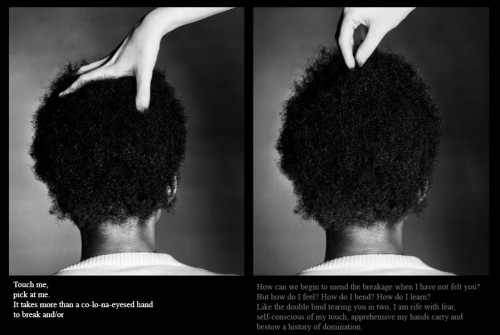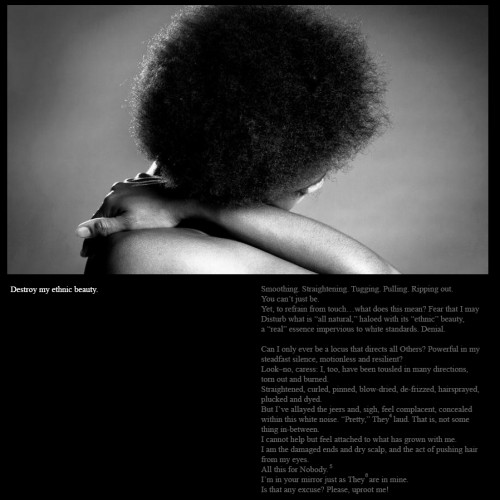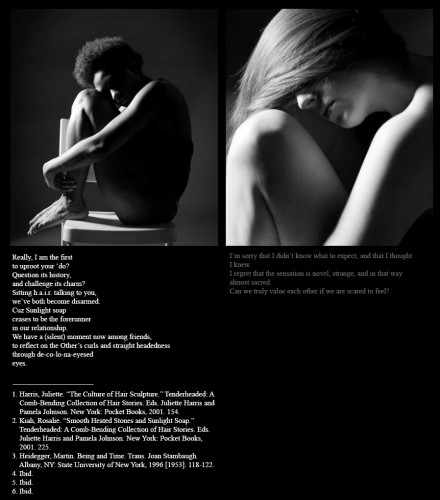HAIR TALK: A (SILENT) CONVERSATION BETWEEN AFRO- AND WHITE- TEXTURED ROOTS
Charmaine Grant, Sarah Steadman, and Pierrette Masimango
PDF of this piece // PDF of Issue 1
Next PieceABSTRACT: This photographic and written piece is an extension of a conversation that has taken place along the course of a growing friendship. The first time we touched each other’s hair, it illuminated the bond we shared and what was missed because of the silences surrounding our respective hair stories. The mirroring of images and text embodies the dynamics of our deliberation of colonial history and racialization and how this dynamic affects our personal relations. As in conversation, there are moments where discussion culminates in agreement or even revelation, as well as points of departure.
ARTIST STATEMENT
Charmaine: In Hair Talk, I resist the old, familiar tugging and pulling of my hair, which started some time ago when Mama would fight against the natural curl pattern of my childhood kinds—combing them to straightness just long enough to be able to elongate, coil by coil and with #2 Action Braid Zizzy Hair extensions, the Afroed mass on my head. I learned then that my teeny, tiny ’fro was not enough to stand on its own—it had to be tamed, denaturalized, with the white-haired beauty that Mama held clenched between her thumb and index fingers and would braid into my tightly coiled nap.
What I did not anticipate was that the same whiteness that supplanted my kinky roots would also be responsible for unclenching the hair stories I kept secret from the white population and tightly wrapped up in my Afro. In this respect, Hair Talk is about the conversation started among friends, because the bonds of friendship helped to start a conversation about Afro hair that would have been more difficult among strangers. These bonds therefore act as a framing device for redefining the colonial relationships[1] between comb and kink, between black and white, between the voiced and the voiceless. Through my friendship with Sarah, these binaries have dissolved and have been replaced by a tender-heartedness to know the other’s hair story by and through the act of touch. “Can we truly value each other if we are scared to feel?” asks Sarah. To this, I respond, “No, we can only begin to appreciate one another’s humanness in the sensation of the conversations around which that humanness is evoked—in the touch and feel of Hair Talk.”
Sarah: As a friend, I have come to realize and feel remorse for the lack of space to explore the way in which hair textures social life and tells a unique story. While the process of Othering is oppressive and debilitates conversation, it is, paradoxically, only through the eyes of the Other that I am incited to reflect upon, re-think and un-think my own positionality. I had forgotten my own hair story until prompted by Charmaine’s ’do. This prompting led me to wonder how to interrogate racialized boundaries, to develop mutuality and, above all, to deeply care for an other, when one does not know how to share in the most basic and tangible way. To me, Hair Talk represents my struggle within colonial history, an attempt to work through the societal impressions and implications within which I am entangled: what it means to be a white woman and an academic who does not know the everyday experience of black women, but yet so thoroughly enmeshed in a friend’s understanding of herself.
[1] By “colonial relationships” I mean to refer to those ideas that Brown White (2005) uses to help explain Black women’s struggles with their hair as being a product of cultural hegemony and white supremacy. In spite of the truth behind these ideas, they necessarily pit Black and White women against each other as well as the meanings that each ascribes to her hair. The inherent difference in these meanings culminates in the understanding that Black and White women’s efforts to comprehend and value the other’s hair story are thwarted by how differently this story grows from the roots on their heads.
Charmaine Grant is a PhD student in the Joint Graduate Program in Communication and Culture at Ryerson and York Universities. An aspiring scholar on Black hair culture, she aims, in her work, to give voice to those whose voices have historically been silenced. Charmaine is equally passionate about playing soccer and about pursuing a career as an American Sign Language Interpreter.
Sarah Steadman is pursuing her Master’s degree in Sociology at York University. Her thesis focuses on the significance of collective memory to the activities of indigenous grassroots movements and to the conception of non-national forms of community. Sarah’s lifelong passion for visual arts—specifically portraitures and life drawing—has particularly inspired her collaboration in Hair Talk.
Pierrette Masimango is a scriptwriter, video producer, and photographer. With a focus on portraiture and nude photography, she works to reveal what lays behind one’s outward appearance: the soul. She is currently working on a series of portraits with bodybuilders to explore the growing obsession of fitness in North America.
Acknowledgments
To Pierrette Masimango (www.pierrettemasimango.wordpress.com) for her photography and photo editing work. It was truly a pleasure for me to be photographed by you a second time. To Julius Ding for the use of his studio space. To Professor Celia Haig-Brown for introducing me to decolonizing research methodologies. Thank you Sarah Steadman for agreeing to be photographed alongside me, for being unafraid to touch and pick at my Afro, and for writing about our photographic session together with an honesty that beautifully fits into my de-co-lo-na-eyesed hair journey. Thank you to Ali Ismail for building the website on which this hair conversation appears. Thank you to Bradley Labuguen for Photoshop editing work. To my Afro, for being silent just long enough for me to decide how to voice your cottony whisper; to decide how to make you speak.

